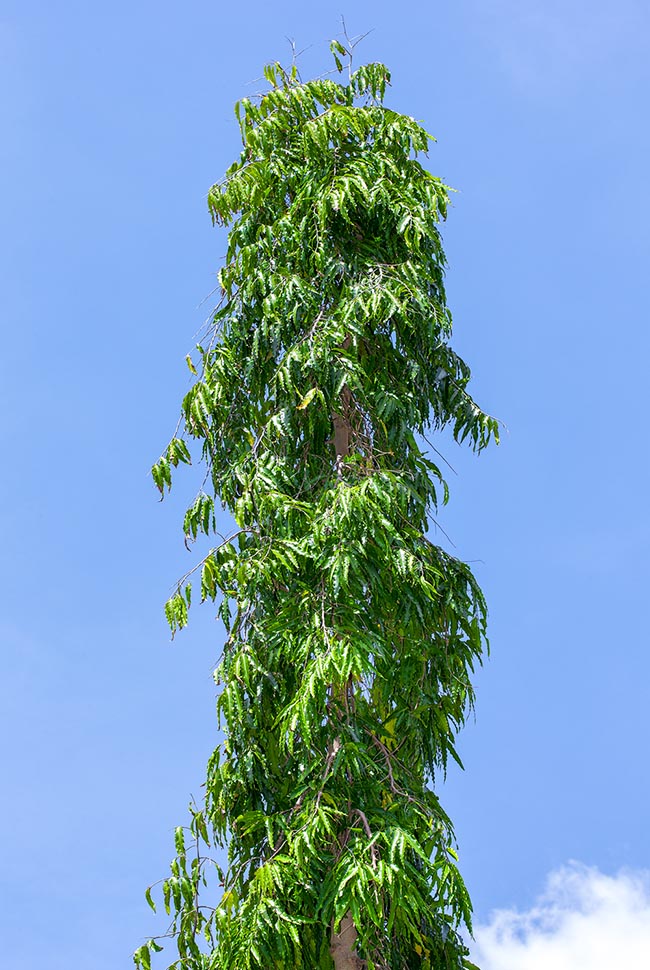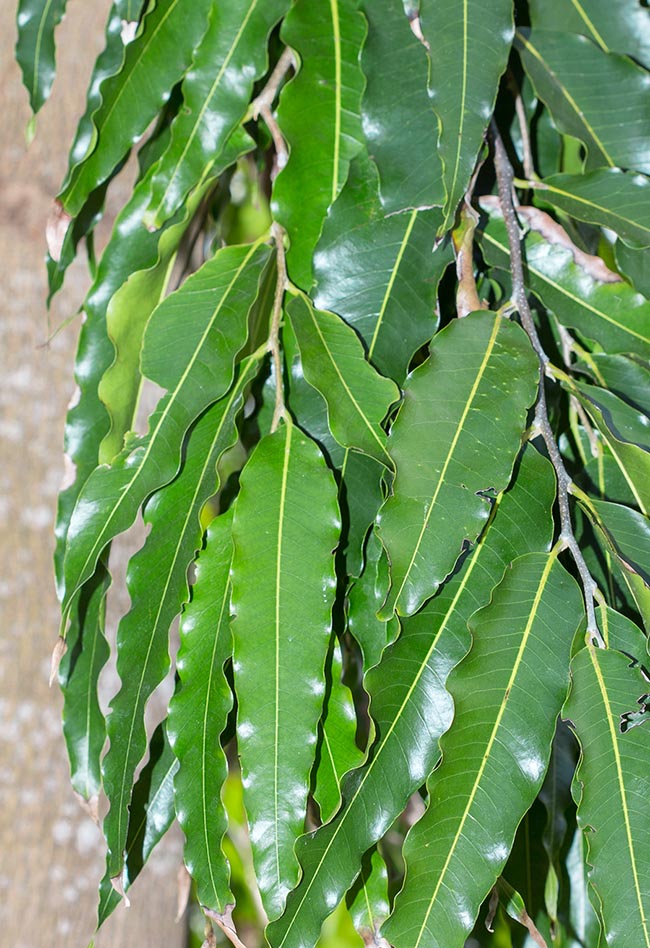Family : Annonaceae

Text © Pietro Puccio

English translation by Mario Beltramini

Native to Sri Lanka the Polyalthis longifolia is an unusual columnar evergreen tree that reaches the 20 m of height with straight undivided trunk and thin branches, 1-2 m long, hanging, longer at the base up to touch the soil © Giuseppe Mazza
The species is native to Sri Lanka, where it grows in the forests at low altitudes.
The name of the genus is the combination of the Greek terms “πολύς” (polys) = much and “ἀλθαία” (althaia) from the verb “ἀλθαίνω” = to cure, due to the curative properties ascribed to the plants belonging to it; the specific name is the combination of the Latin terms “longus, a, um” = long, and “folium, i” = leaf, with obvious reference.
Common names: cemetery tree, false ashoka, Indian fir, Indian willow, mast tree, telegraph pole tree, weeping Polyalthia (English); cháng yè àn luó, chuí zhī àn luó (Chinese); acokam, arana, asapala, ashoka, asoka, asokamu, assoti, celai, celokatam, chorani, debdari, debdaru, devadar, kacupam, kambadamara, kirimaran, nara maamidi, nara namidi, nettilingam, pundi, pungu, ravadam, suvattai, ubbina mara, ulkatah, vanamutti (India).
The Polyalthia longifolia (Sonn.) Thwaites is a columnar evergreen tree, 12-20 m tall, with straight trunk, undivided, with smooth brown greyish bark and slender branches, 1-2 m long, longer at the base up to touch the soil.
Leaves, on a 0,5-1 cm long petiole, simple, alternate, ovate-lanceolate with wavy margins and acuminate apex, of glossy dark green colour above, paler below, more or less coriaceous, 12-30 cm long and 3-7 cm broad; the young leaves display a bronze shade that creates a nice contrast with the rest of the foliage.
Axillar inflorescences on the one year old branches, sessile or on a short peduncle, fasciculate, racemose or umbelliform, bearing numerous bisexual flowers, of 3-4 cm of diameter, of greenish yellow colour.
2-4 cm long pedicel, calyx with 3 ovate-triangular sepals, 2-3 mm long, tomentose externally, corolla with 6 petals arranged in two series of 3, lanceolate-triangular with acute apex, pubescent, 1,3-1,8 cm long and about 0,3 cm broad, numerous stamens, about 1 mm long, gynoecium formed by 20-25 free monovular carpels, 1-2 mm long, and sessile stigma.
The fruit is formed by 10-20 separated monocarps, ovoid, initially of green colour, then blackish purple, 2-2,5 cm long and of 1,2-1,5 cm of diameter, containing each one an ovoid seed of pale brown colour, about 2 cm long and of 1,2 cm of diameter.

Elegant glossy dark green leaves, ovate-lanceolate with wavy margins and acuminate apex. Plant sacred for the Hindu populations. Fast growth in the tropics. Useful for anti-noise and wind-breaking barriers. Medicinal properties © Giuseppe Mazza
The fruits are a source of food for bats and birds that contribute in the dispersion of the seeds.
It usually reproduces by seed, that has a short lasting germinability, in particularly draining loam maintained humid at the temperature of 24-28 °C, with germination times from 2 to 6 weeks; it can propagate also by cutting and by air layering.
Extensively cultivated for ornamental purposes in the tropical and subtropical countries, with constantly humid and rainy climate as well as with a marked dry season, especially as road tree, in particular the variety ‘Pendula’ with branches tighter to the trunk, and for shields and anti-noise and windbreaks barriers.
Fast growing, it requires full sun, it adapts to an ample variety of soils and resists to the urban pollution; after the first phase of planting, when it needs moderate watering during the dry periods, no particular cares are necessary.
Bark and leaves are variously utilized in the traditional medicine, in paricular the Indian one, laboratory studies have shown in the extracts antibacterial, antiinflammatory, antihyperglycemic, antioxidant, anticancer, hepatoprotective, antipyretic, hypotensive and purgative properties of possible interest for the official pharmacopoeia.
The plant is sacred for the Hindu populations and for this reason it is often placed around the temples, and utilized in numerous ceremonials and religious rites.
The wood, of clear colour, of medium hardness, easy to work, but not long lasting, is utilized for boxes, matches, pencils and various common use craft items.
In the past, the wood, due to its flexibility, was used to fabricate casks and the trunks, tall and straight, for the masts of the sailing ships and the telegraph poles.
Synonyms: Uvaria longifolia Sonn. (1782); Uvaria altissima Pennant (1798); Unona longifolia (Sonn.) Dunal (1817); Guatteria longifolia (Sonn.) Wall. (1832); Unona altissima Russell ex Wall. (1832).
→ To appreciate the biodiversity within ANNONACEAE family and find other species, please click here.
